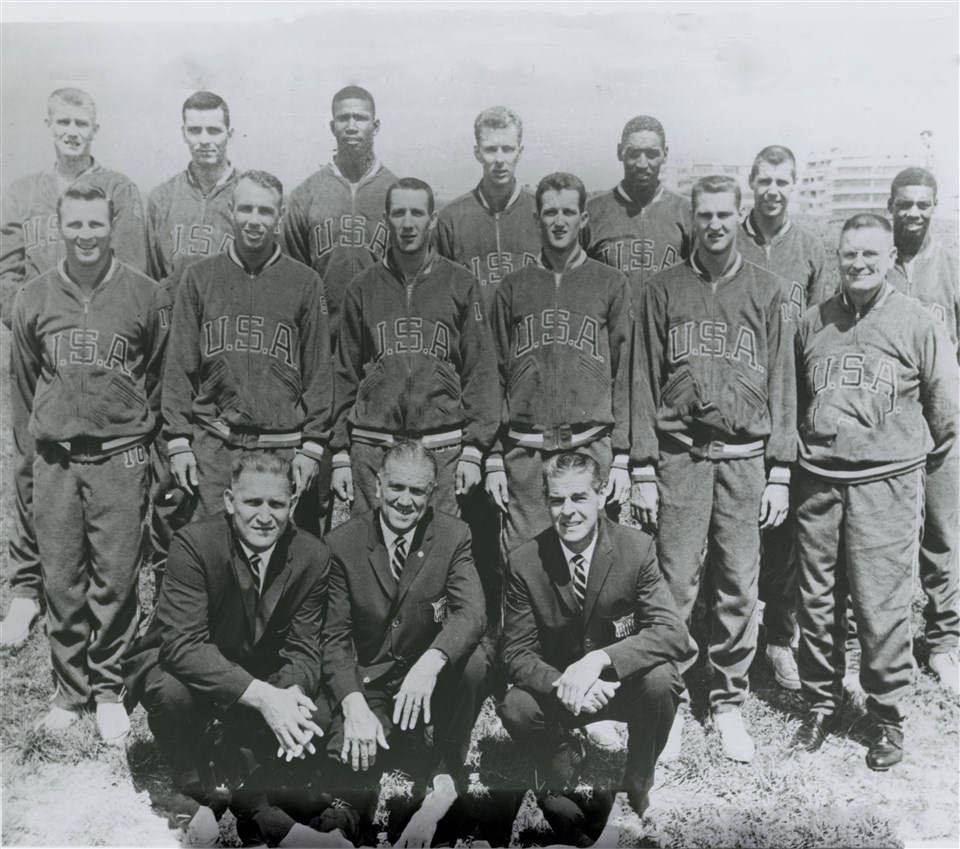 History of the 1960 United States men's Olympic basketball team
History of the 1960 United States men's Olympic basketball team
Going into the 1960 Olympics in Rome, it looked like the US could be beaten. The US had lost in the World Basketball Championships and the world claimed to be catching up. Instead, the US assembled one of the best national teams the country and world had ever seen. But just because the US assembled one of its best teams did not mean that there were no contraversies surround the roster.
The US held trials for the roster. Previously teams were selected from the best AAU team and the best NCAA team, but now the AAU and NCAA were fighting over who would control amateur basketball and by in USA basketball.
The trials were held in Denver, Colorado and consisted of eight teams; cheif amongst them was the Ohio State Buckeyes national championship team; a team of NCAA all-stars, the NAIA all-star team, and the AAU champion Peoria Caterpillar Cats. The NCAA all-stars won the tournament handily. and because of this Pete Newell was named head coach and 1956 head coach Warren Womble as his main assistant.
Because of the disagreement between the NCAA and AAU a compromise was struck, which saw many of the top players in the NCAA left off the squad. The two biggest snubs where Ohio state guard John Havlicek and Providence guard Lenny Wilkens.
The compromise lead to 8 NCAA stars from 8 different colleges being named to the two, four AAU stars (two from the Caterpillars) and one member of the US Armed Forces team being selected for the roster.
The Americans first game was against the host nation Italy. Italian fans were thrilled to see team USA and hoped for the upset but the US put the game away early. Adrian Smith scored 18 points to lead the US to an 88-54 win.
Next the US played Japan and like in 1956, the US blew out the Japanese team. The US lead 65-36 at the half and won 125-66 behind 28 points from Jerry Lucas.
The US finished pool play with another blow out win, this time beating Hungary 107-63 behind 22 points from Oscar Robertson.
The US entered the second pool of play and trounched Yugoslavia. The US lead 63-16 at the half and ended up winning 104-42. Robertson lead multiple double digit scorers with 16.
The US faced little resistance when they smashed Uruguay 108-50. The US scored 65 points in the first half of this game, which was 13 more than the Uruguayans scored the entire game. Smith once again lead multiple US scorers with 15.
The US finally faced some competition in their last pool game vs the USSR. Once again the Soviets tried to slow the US by slowing the game down, and it worked - somewhat. The US took a 35-28 lead into the half before getting hot in the second half and winning 81-57 behind Jerry West's 19 points.
In the Medal round the US had a rematch with the host nation Italy, and actually faced some stiff resistance from the Itallians. The US lead 56-48 at the half and wib 112-81. The US was upset at the officiating seemed to favor the host nation in the first half.
Normally the US would have faced the USSR, who beat Brazil and Italy, for the gold medal, but a scheduling change had the US face Brazil for the gold medal. Had Brazil won than the USSR would have won gold, Brazil Silver, and the US bronze. The schedule change confused many fans who were upset not to see a USA vs USSR rematch.
As expect the US cruised to an easy win and their fifth gold medal, winning 90-63 behind Jerry Lucas's 23 points.
The 1960 was the gold standard all future teams were compared to. In 2010 the team was inducted into the basketball hall-of-fame; along side the 1992 Dream Team. Nine members went on to play in the NBA, a change from previous teams where most players stayed amateur after their Olympic expereince. Four players - Robertson, Lucas, West and Bellamy - have been inducted into the hall-of-fame. The squad makes up 43 all-star appearances, one all-star MVP (Smith), four Rookie of the years (Robertson, Dischinger, Bellamy, and Lucas) and one Regular season MVP (Robertson).
Oscer Robertson lead the team in scoring at 17.3 points per game. He went on to one of the best careers in NBA history, winning MVP when he averaged a triple-double for an entire season.
Jerry West also had one of the best careers in NBA history. He is the logo after all.
Walt Bellamy started out as one of the best bigmen in NBA history, but his career quickly fizzled out.
Bob Boozer, Terry Dischinger, Darrall Imhoff, Jerry Lucas and Adrian Smith all had NBA all-star careers. Imhoff is probably most famous for being the opposing center when Wilt Chamberlain scored his 100 point game.
Burdie Haldorson was a member of the 1956 team as well.
Allen Kelley and Lester Lane where the only two members of the team never to play in the NBA.
| 
